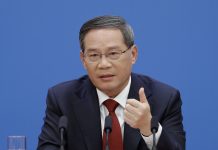From Li Yunqi
Last year, 2.4 trillion kilowatt-hours of electricity were transmitted from western China to the east — enough to power five Germanys.
More than 80% of that electricity came from clean, renewable sources, a result of China’s West-to-East Power Transmission Project, one of the most ambitious and transformative energy initiatives in the world today. Since its launch, the project has reshaped the nation’s energy landscape by channeling vast amounts of clean power from China’s resource-rich western regions to its densely populated and industrialized eastern coast — traveling thousands of kilometers, crossing mountains, deserts, rivers, and reaching over 500 million people in major cities like Shanghai, Guangzhou, and Beijing.
The project was first formally proposed in the early 2000s and became a key part of China’s national development strategy in 2001. It was born from a structural imbalance: eastern China, home to the country’s most concentrated economic activity and highest electricity demand, lacks the space and natural conditions to generate large-scale renewable energy. Meanwhile, the western regions—Xinjiang, Qinghai, Yunnan, Inner Mongolia—are rich in solar, wind, and hydropower resources but historically lacked sufficient local demand and infrastructure to distribute this power nationally.
Inner Mongolia leads the country in wind power, with over 86 gigawatts of installed capacity, making it China’s largest wind energy base. In Qinghai, the Hainan Prefecture Ecological Solar Park—one of the largest solar farms in the world—spans the high-altitude plateau with 15 gigawatts of installed capacity. Meanwhile, Yunnan and Sichuan play a major role in hydropower generation, harnessing their fast-flowing rivers and rugged terrain.
In contrast, eastern cities, while being China’s economic powerhouse, are dense, industrial, and energy-hungry. Mega-regions like the Yangtze River Delta and the Pearl River Delta are home to China’s most productive manufacturing hubs and urban centers. These areas have long relied on coal-fired power and, until recently, had limited access to the abundant renewable energy produced in the west, leaving much of it underutilized.
This disconnect between where clean energy is produced and where it’s needed is not unique to China. Around the world, urban and coastal centers demand the most power but rarely have access to renewable-rich landscapes. China’s answer to this dilemma has been to physically connect the country through high-efficiency, long-distance electricity highways.
Closing this energy gap will benefit not only China, but also contributes to the world’s transition to cleaner energy.
What makes this power transfer possible is China’s development and deployment of ultra-high voltage (UHV) transmission technology. Unlike conventional power lines, UHV lines can carry electricity over thousands of kilometers with very little loss. China began investing in UHV research in the early 2000s and now holds over 80 percent of the world’s UHV-related patents. By the end of 2023, the West-to-East Power Transmission Project consists of 39 long-distance UHV corridors, creating an interconnected network that functions as the green arteries of the country’s power system.
Building on its domestic success, China also began sharing its UHV technology with the world.
“China is willing to work with the international community to comprehensively strengthen energy cooperation, safeguard energy security, address climate change, protect the ecological environment, and promote sustainable development, so as to better benefit people around the world.” — Chinese President Xi Jinping
China’s ultra-high voltage (UHV) technology is already making its mark beyond its borders. Earlier this year, China State Grid’s Brazilian subsidiary officially kicked off a ±800 kV UHVDC transmission project in northeastern Brazil, marking State Grid’s third overseas UHV transmission project. The project will integrate wind, solar, and hydropower from Brazil’s northeastern and northern regions, transmitting it through the states of Maranhão, Tocantins, and Goiás to supply electricity to Brasília and surrounding areas—serving a population of around 12 million.
These international projects not only demonstrate the technical reliability and efficiency of China’s UHV systems but also reflect a growing commitment to global energy connectivity and low-carbon development.
China’s West-to-East Power Transmission Project proves that clean energy doesn’t have to stay where it’s made. With the right mix of ambition, innovation, and infrastructure, renewable power can cross mountains, deserts, and megacities — lighting up entire nations. As the world searches for solutions to an accelerating climate crisis, China’s energy superhighway offers a bold blueprint for what’s possible.
– Author Li Yunqi is a journalist with CGTN Radio, focusing on consumer habits among China’s younger generation, developments in the ESG sector and cultural trends.





